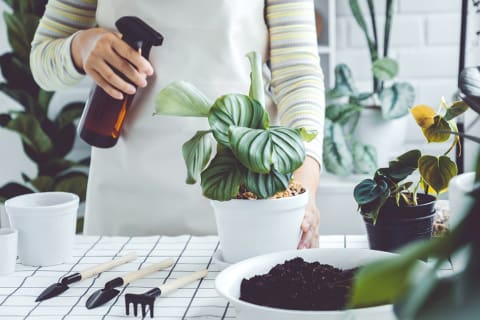Here are the whats, wheres, whens, whys, and hows of the plant world’s favorite bug spray. The Environmental Protection Agency has approved neem oil as a pesticide, thanks to its waxy consistency that traps bugs and its active ingredient, Azadirachtin. This chemical mimics a bug’s natural hormones but disrupts its ability to feed and lay eggs1. When routinely sprayed on a plant, it will cause any hungry bugs who eat it to “eventually starve as well as have their maturation and reproductive cycles interrupted,” Leslie F. Halleck, M.S., a certified professional horticulturist and author, explains. “It can also suppress new eggs from hatching and can potentially disrupt insect developmental and reproductive hormones.” Azadirachtin aside, the nonactive compounds of neem oil—called clarified hydrophobic neem oil—can also be used to essentially smother bugs like fruit flies, fungus gnat larvae, and mealybugs on contact. So “neem oil” can actually refer to two types of products: Popular plant varieties that you can spray with neem oil include: Finally, don’t apply neem oil to plants that are sitting in a bright window. “As with any horticultural oil, it’s best not to apply to plants when they are exposed to direct sun rays to avoid leaf scorch,” Halleck says. Before spraying, move your plant into a darker room like the bathroom for application and wait two to three days before putting it back in a sunnier spot. This should leave enough time for the neem oil to break down. Neem oil can also damage your plants’ leaves if used in high quantities, so you always want to follow the instructions on the bottle before spraying. Even if your plant is healthy and bug-free, you can apply neem oil every so often as a preventive measure. If you’ve dealt with bugs in the past or live in a warm, humid climate where insects thrive, you may want to get into the habit. Emma received her B.A. in Environmental Science & Policy with a specialty in environmental communications from Duke University. In addition to penning over 1,000 mbg articles on topics from the water crisis in California to the rise of urban beekeeping, her work has appeared on Grist, Bloomberg News, Bustle, and Forbes. She’s spoken about the intersection of self-care and sustainability on podcasts and live events alongside environmental thought leaders like Marci Zaroff, Gay Browne, and Summer Rayne Oakes.




